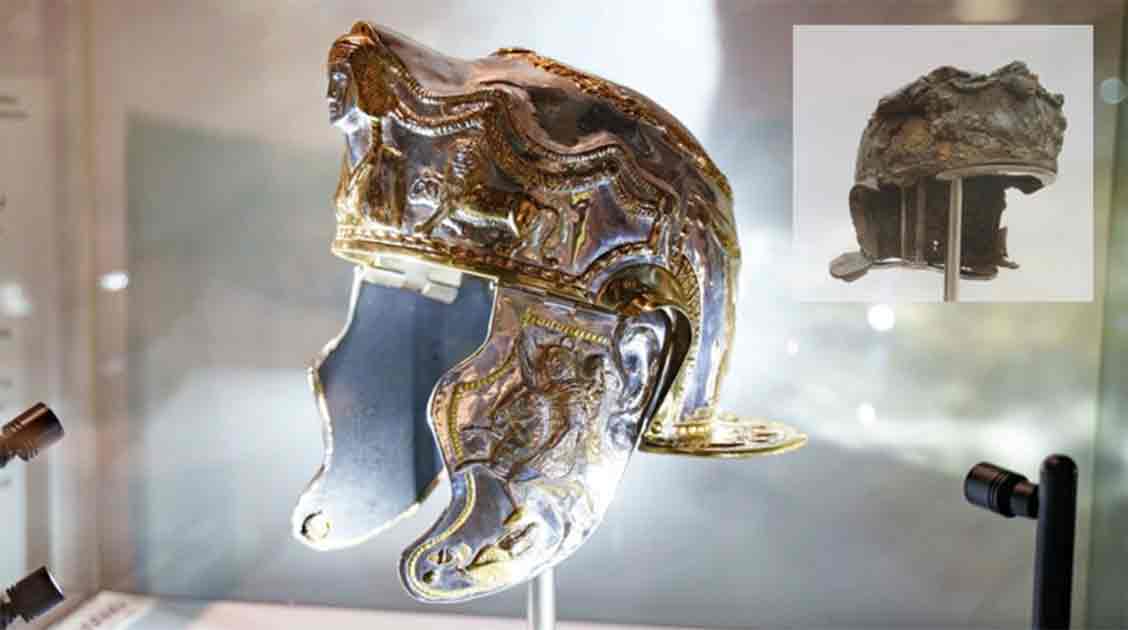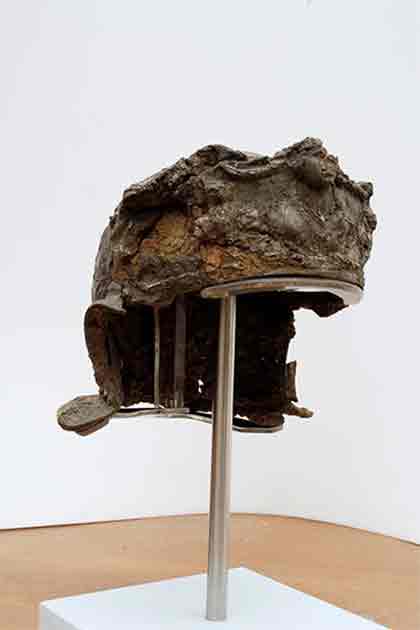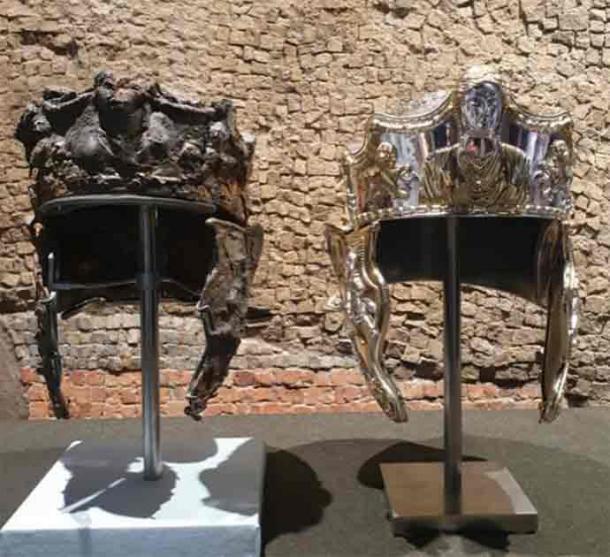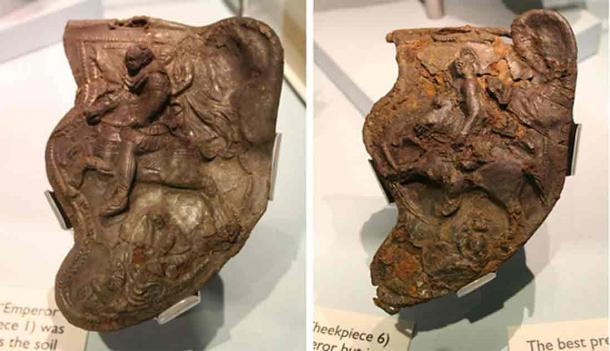A Roman cavalry helmet, initially called a ‘rusty bucket’ has been replicated to show its former glory, 23 years after the original was found in a field in Leicestershire, England. The Hallaton Helmet – part of the Hallaton Treasure hoard – was buried in a native British sanctuary during the Roman invasion of Britain from 43 AD onwards. The remarkable artifact from Britain’s Roman past is believed to have belonged to a high-ranking Roman cavalry officer.

Discovered in 2001 by the Hallaton Field Work Group and the University of Leicester Archaeological Services during the excavation of an Iron Age site, the helmet was found in fragments, with wider excavations of the site yielding more than 5,000 coins and silver ingots, along with pig bones, leading the investigators to conclude it was some sort of shrine or place for offerings.
After years of meticulous reconstruction work by conservators at the British Museum, the original helmet assumed something like its original form, including intricate decorations.

The restored original helmet. (CC BY 2.0)
The temptation to see just what the helmet would have looked like when it was originally sat atop the head of a Roman cavalryman was just too much to resist. Harborough Museum staff and dedicated volunteers engaged in fundraising for the project, which was provided by Leicestershire Archaeological and Historical Society. Then the meticulous process of crafting two replicas of the Hallaton Helmet began, reports a press release by De Montfort University, Leicester.
Reproduction of the original Hallaton helmet (left) and the ‘as new’ reproduction (right). (De Montfort University Leicester)
A Painstaking Reassembly Inspires A Reproduction
The painstaking reassembly of the Hallaton Helmet, with around 80% of the original structure intact, was a remarkable achievement. Gaps were filled to ensure stability, while the once-shining surface was carefully restored. But is still lacked its once gleaming silver surface. And decorative elements such as the laurel wreath on the brow, the leaf motif on the neck guard, and the crown on the dome were likely once adorned with gold leaf, enhancing the helmet’s impressive appearance.
With the restoration of the original complete, it was decided this glorious helmet needed to be seen as it once was.
In order to replicate the iconic Hallaton Helmet, Rajesh Gogna, a distinguished silversmith senior lecturer and practice-based researcher hailing from Leicestershire, employed cutting-edge techniques. He meticulously crafted a model of the helmet, which served as the blueprint for its reproduction. Utilizing advanced 3D printing technology, the model was faithfully recreated in plastic before being meticulously silver-plated and adorned with gilded accents, reports BBC.
“It has been a really exciting project to work on, which was completed over six months. There was a lot of complexity in creating the renders and a lot of finessing and finishing by hand because there’s so much detail which we wanted to bring out. This commission has helped me push my own practice and work with new techniques. It really ties in with my area of interest which is looking at how craftspeople can embrace technology to expand their creativity,” explained a delighted Gogna.
Meanwhile, archaeologist and seasoned replica maker Francesco Galluccio took a more traditional route in his pursuit of replicating the illustrious artifact. Drawing upon ancient methods reminiscent of those employed by the original Roman armorers, Galluccio painstakingly handcrafted a faithful rendition of the Hallaton Helmet.
Symbolism and Homages: Understanding the Advanced Metallurgy of the Romans
Crafted from iron plating overlaid with a thin layer of gilded silver, the helmet features stunning repoussé designs across its surfaces – a homage to the advanced metalworking skills of its Roman artisans.
The laurel wreath symbolizes military triumph; the brow guard is adorned with a striking bust of a woman flanked by lions and other animals. Originally, the helmet featured two hinged cheek pieces to protect the sides of the face, but these are now conserved separately due to their fragility.

Parts of the decorated cheek pieces of the helmet. Remains of 7 cheekpieces in all were found, meaning there were pieces of several helmets left at the shrine.( Left, CC BY-SA 4.0. Right, CC BY-SA 4.0)
One of the cheek pieces depicts a Roman emperor on horseback, with the goddess Victoria flying behind him. Beneath the horse’s hooves lies a crouching figure, possibly a native Briton, and archaeologists feel this is reflective of the complex relationship between the Roman invaders and the local population, reports LBV Magazine.
The frontal crest of the helmet showcases a prominent female figure, likely a Roman goddess or empress, possibly flanked by lions. This section has a silver sheet directly applied over a sandy core rather than an iron base.
Councillor Christine Radford, Cabinet Member for Adult Social Care and Communities concluded:
“We are excited to have the Hallaton Helmet back with us at Harborough Museum for people to view. This re-display would not be possible without the amazing conservation and reconstruction work which has been undertaken… There has also been a lot of behind the scenes work from the staff in the Museum Service, who have created lots of content to tell the story of the helmet and its discovery. I do hope you all get the chance to head down to the museum, to experience this historic artifact.”
Additionally, five cheek pieces from other helmets and associated objects buried alongside the Hallaton Helmet are being exhibited for the first time since their conservation was completed in 2020.
The Hallaton Helmet exhibition will be on display at the Harborough Museum starting on Wednesday, March 20th. It was funded and supported by the Leicestershire Archaeological and Historical Society, the Market Harborough Historical Society, Leicestershire Fieldworkers, The Friends of Leicester and Leicestershire Museums, the Market Harborough & the Bowdens Charity, and the National Lottery Heritage Fund.
Top image: Replica of the Hallaton Helmet. The original is set to be displayed at the Harborough Museum in Leicestershire, UK. (Inset; the original helmet) Source: Harborough Museum (Inset; CC BY 2.0)
By Sahir Pandey